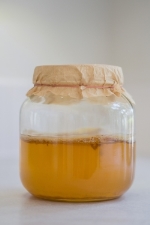Finally researchers have demonstrated the existence of biofilm in Lyme disease in human tissues.
For many years we have been suspicious that the spirochetes which cause Lyme diseases are so difficult to treat because they high behind a slimy layer of tissue called biofilm. Many different varieties of bacteria make biofilm on all kinds of surfaces.
IV catheters form a layer of biofilm at the tip which sometimes prevents
us from drawing blood
 through them. People with chest ports or PICC lines can relate to that issue.
through them. People with chest ports or PICC lines can relate to that issue.
Kombucha – the fermented tea drink – forms a biofilm called a “Scobie” that floats to the top of the fermenting vat.
Wounds may form a biofilm which prevents oxygen from getting to the wound bed, and prevents healing.
An excellent article published in 2013 reviewed the evidence for persistent infection in Lyme disease, and why the organism is so clever at evading detection by the immune system.[1]
Now we know why the Lyme organism is so difficult to treat.
We finally have evidence that biofilm grows in human tissues as well. Researchers examined biopsy specimens of skin swelling in patients known to be infected with Borrelia by several different methods. They found significant amounts of both Borrelia spirochetes and layers of protective tissue formed largely from a substance called alginate, commonly known as biofilms.[2]
This finding should put to rest the debate about whether “chronic Lyme disease” is a figment of the imagination or a real and persistent infection in patients with persistent symptoms after theoretically adequate treatment for Lyme disease.
For more information about treatment of chronic Lyme disease, please call us at 480-240-2600 to speak with our patient coordinator or to schedule a free phone consultation with one of our practitioners.
[1] Berndtson K. Review of evidence for immune evasion and persistent infection in Lyme disease. Int J Gen Med. 2013; 6: 291–306.
[2] Sapi E, Balasubramanian K. Evidence of in vivo existence of Borrelia biofilm in borrelial lymphocytomas. European Journal of Microbiology and Immunology. DOI: 10.1556/1886.2015.00049
